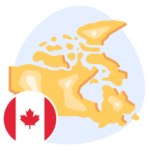If you’re looking to study abroad in Canada, you might be wondering how long an academic year lasts in Canada. The length of the academic year, as well as when each semester starts, can impact when you need to begin your studies and when you should apply for a study permit.
Read on to learn more about the academic calendar in Canada. We’ll also cover how to apply for a student visa, also called a study permit in Canada.
Our free ApplyBoard platform can connect you with thousands of study programs which start all through the academic year. Try it today!
The Academic Year in Canada
In Canada, an academic year is different from a regular calendar year (which runs from January to December). Generally, the academic year spans from September of one year to August of the following year.
An academic year is typically organized into semesters. How many semesters there are may vary, depending on your study level. At primary and secondary schools, the academic year typically runs from September to June, and is divided into three semesters. Students are generally not in school in July and August unless they’re taking summer school classes.
At the post-secondary level, there are two main semesters:
- Fall semester, which runs from September to December
- Winter semester or Spring semester, which runs from January to April or May
Some institutions also offer a summer semester, which runs between May and August.
Note: Each post-secondary institution may have its own academic calendar. So, semester start and end dates may vary from institution to institution.
If you’re planning to start your post-secondary education in Canada in the fall semester, it’s often best to arrive in August. This will give you time to get settled and attend your college or university’s orientation events.
Summer Programs
Many Canadian colleges and universities offer summer programs between May and August, which is a “third” semester. Summer semesters can be especially helpful for students who want to accelerate their studies or stick to a routine throughout the year instead of taking a summer break.
To help you decide if taking a summer semester is right for you, check out our list of pros and cons of enrolling in summer studies.

How to Apply for a Canadian Study Permit
If you’re wondering how to study in Canada, the first step is enrolling in a study program at a designated learning institution (DLI). After you’ve applied to a program, the college or university will review your application. As part of this application, you may need to put together paperwork that you’ll need again for your student visa application, so be sure to keep copies!
Depending on the institution you apply to, and what study level you are applying for, processing your application can take anywhere from a few days to a few weeks. If you’re accepted, the university or college admissions team will send you a letter of acceptance (LOA) and a provincial or territorial attestation letter (PAL or TAL). You’ll also have to pay your tuition deposit.
Note: Provincial or Territorial Attestation Letters (PALs/TALs) are a new Canadian study permit requirement as of January 2024. A PAL or TAL proves that a student’s enrolment aligns with the national limit for study permit applications.
Documents Required for Canadian Student Visa
Once you’ve been issued your LOA and PAL/TAL, it’s time to fill out all the documents you’ll need for your Canadian student visa, also known as a study permit.
It’s always a good idea to check the official website for the Government of Canada for the latest updates on which documents you’ll need to complete or share during your visa application. We advise applying at least 120 to 150 days before the start of the academic semester your program begins in.
Some documents and information you’ll need to prepare include your:
- Letter of acceptance (LOA)
- Letter of attestation (PAL/TAL)
- Proof of identity
- Proof of financial support
Note: If you’re planning to study in Quebec, you’ll also have to apply separately for a Certificat d’acceptation du Québec (Certificate of Acceptance to Québec, or CAQ) and include it with your study permit application.
Exactly what documentation you need will depend on the instructions from your local Canadian visa office.
You may also need to demonstrate or complete:
- A custodian declaration (minor students only)
- A letter of explanation / study plan
- A medical exam
- Your travel history
- Ties to your home country
Before you submit your application, read our list of do’s and don’ts when applying for a Canadian student visa. Also check out our tips on how to write a study plan for your Canadian study permit application.
Before you submit your application, go through your documents carefully and make sure they’re all completed! Remember, if any of the documents are in languages other than English or French, they must be officially translated before submission.
Pre-Arrival Checklist
Once your Canadian student visa is approved, you’ll need to prepare for your journey to Canada! Before you head to the airport, make sure you have all of these items with you:
- Physical copies of important documents
- Cash
- Any prescription medication
- Electronic devices
- Weather-appropriate clothing
Plus, pack the following documents in your carry-on luggage so you can access them easily:
- Your passport
- Your study permit and PAL/TAL
- Your Letter of Acceptance/Admission as well as your institution’s address and contact details
- Personal identification documents
- Proof of financial support
- Accommodation confirmation and full address

Arriving in Canada
Once you arrive in Canada, you’ll have to complete an interview with a Canadian border services (immigration) officer at the airport. You may need to show some or all of the documents listed in the Pre-Arrival section above to them, so keep these documents handy.
During your interview, it can be helpful to:
- Mention specifics about your program and institution
- Explain why you chose your program and institution
- Share examples of job opportunities in your field after you study abroad
- State how you plan to financially support yourself while you study in Canada
Looking for more tips? Read our handy guide on acing your Canadian study permit interview.
Once you’ve passed your interview, you’ll receive your official study permit (which allows you to stay and study in Canada) and will be on your way to starting your first day of class! Enjoy getting to know your new community and learning all about your institution and campus.
Studying abroad can be a rewarding experience that sets you up for life-long success. No matter which semester your programs start in, we hope you feel well prepared to pursue your studies in Canada with confidence. Best of luck on your study abroad adventure!
Ready to take the next step? Pick a program at a Canadian college or university that best suits you on ApplyBoard’s free-to-use platform.



